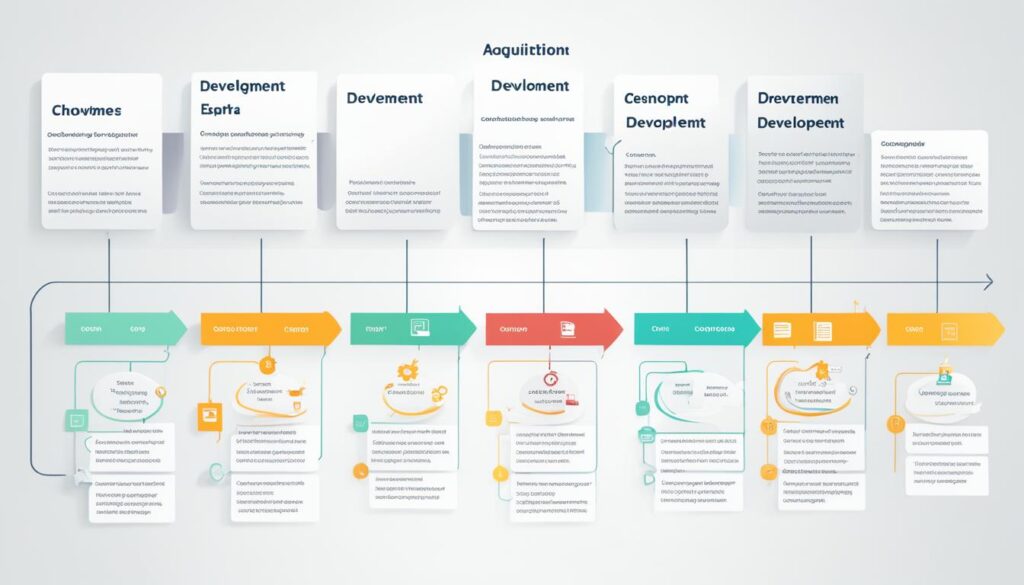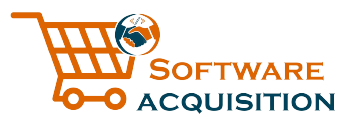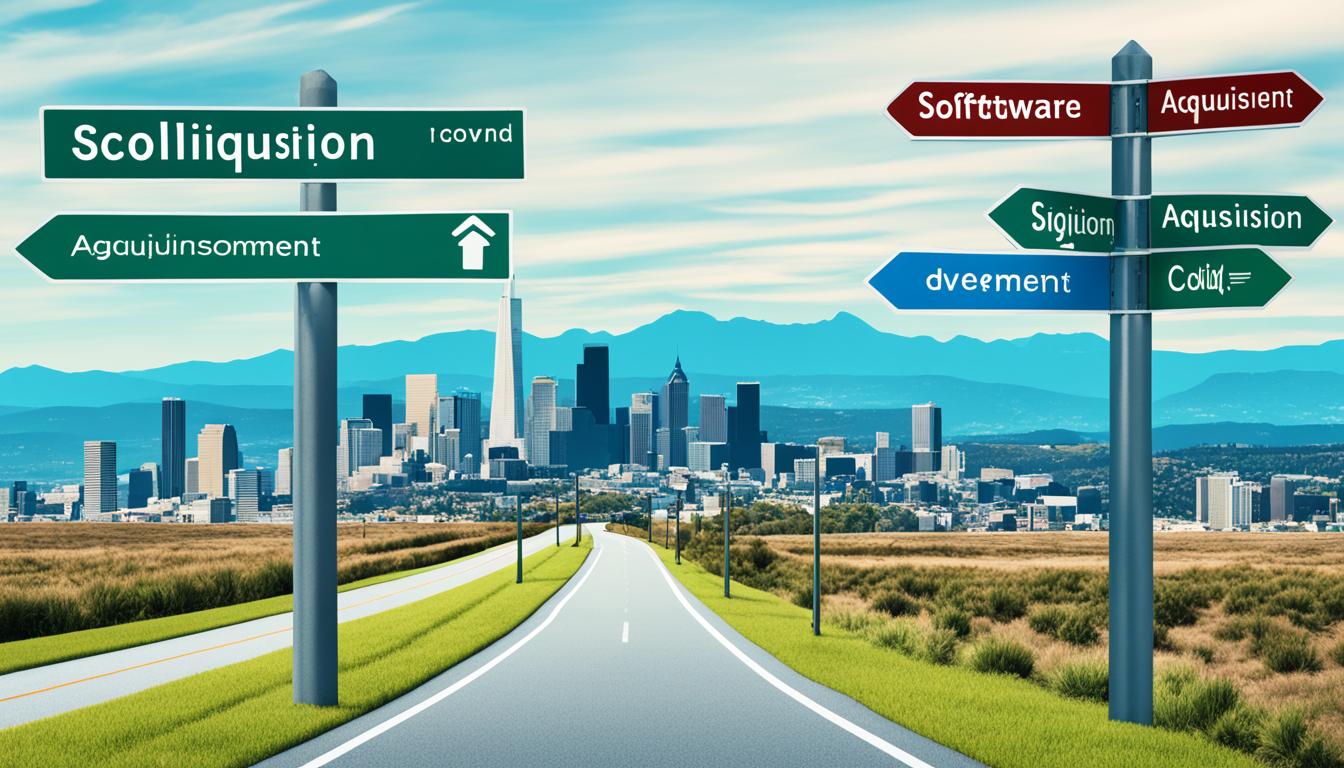Choosing between buying software or building it is a big decision for companies. It’s not just about technology. It involves looking at what the business truly needs, understanding the complex world of software creation, and how to efficiently get the right technology. As more software choices become available, businesses are carefully thinking about whether a ready-made solution or a custom application will better meet their goals.
Key Takeaways
- Assess the specific business needs before deciding on software acquisition vs. development.
- Understand how software engineering advancements influence custom software viability.
- Consider how a strategic software choice aligns with long-term business goals.
- Factor in the scalability and flexibility of solutions in your software strategy.
- Recognize the role of IT procurement in achieving optimal software acquisition outcomes.
Evaluating the Shift in Software Project Management
Software project management has changed a lot because of new technology. With more focus on custom software, knowing about these changes is key. This is vital for companies thinking about their software plans.
The Evolution of Software Development Tools
New software tools have changed project management in IT teams a lot. These tools make work smoother and faster than before. They have made teamwork and efficiency blend perfectly.
Impact of Integrated Development Environments on the Decision Matrix
The way companies choose software has changed too. Integrated development environments (IDEs) make it easier to create software. They help leaders decide if building or buying software is better.
Tailored Solutions: A New Trend in Custom Software
There’s a big move towards custom-made software now. This kind of software fits business needs better. It’s more flexible than off-the-shelf options.
| Aspect | Custom Software Development | Off-the-Shelf Software |
|---|---|---|
| Alignment with Business Process | Highly customized to fit unique needs | Generalized fit with possible gaps |
| Flexibility | Adaptable to changing business needs | Limited by external update cycles |
| Total Cost of Ownership | Cost-effective in long term with ownership | Recurring cost with potential for hidden fees |
| Development Tools | State-of-the-art IDEs and modern frameworks | Dependent on vendor’s development cycle |
Organizations should focus on smart software project management. Using IDEs and custom software can give them an advantage. A good strategy mixes planning and flexibility for real business success.
Understanding Mission-Critical Software in Today's Business Landscape
In today’s fast-paced business world, companies rely heavily on mission-critical software. This software is crucial for key business operations. It helps companies excel in the competitive market.
This technology manages customer relations and handles complex supply chains. It is vital for gaining a competitive edge.

Defining Mission-Critical Software Needs
Understanding what makes software mission-critical is essential. It’s the software that runs important tasks like financial transactions. It ensures these tasks run smoothly without stopping.
Requisites for Business Operations and Competitive Edge
The journey of acquiring the right software is complex. Businesses must consider many things like how the software can grow. It’s also crucial to think about how it works with old systems.
Planning the software development lifecycle is also important. This planning makes sure the software can be updated. It helps the software stay useful over time and react to new market trends.
| Mission-Critical Software Qualities | Impact on Business Operations | Contribution to Competitive Edge |
|---|---|---|
| Reliability | Ensures consistent performance under various conditions | Builds customer trust and reliability in services |
| Scalability | Facilitates growth without performance degradation | Enables swift adaptation to market demands and expansion |
| Compatibility | Integrates seamlessly with existing systems | Saves costs and increases efficiency through the use of current assets |
| Support Structure | Provides a framework for resolving issues quickly | Minimizes downtime and maintains continuous business processes |
Software Acquisition vs. Development: Choosing the Right Path for Your Business
Businesses standing at the junction of software acquisition and software development face a critical decision. The choice of a software acquisition strategy can deeply affect an organization’s efficiency and innovation capacity. It involves deciding between ready-made solutions or custom software development based on several factors, including business needs and the software development lifecycle.

It’s vital to balance the flexibility of custom software with the quick utility of ready-made solutions. Consider your business’s specific needs, the software’s scalability, and its ability to adapt to future changes. Think about the total cost over time as well.
When weighing the options, ask yourself a few key questions:
- Alignment with Business Requirements: Does the solution fit your current and future needs?
- Scalability: Can the software expand with your business smoothly?
- Flexibility: Can it adapt as your business goals or processes change?
- Total Cost of Ownership: Have you looked into all costs, including maintenance and updates?
This table provides a side-by-side view of software acquisition and development.
| Criteria | Software Acquisition | Software Development |
|---|---|---|
| Initial Cost | Typically lower, as costs are shared | Higher, from custom work |
| Time to Implement | Faster, using existing solutions | Varies, based on complexity |
| Customization | Limited by the software’s design | Tailored to fit business perfectly |
| Scalability | Limited by vendor plans | Aligned with business growth |
| Long-term Costs | Includes ongoing fees and feature costs | Focuses on maintenance, with potential savings |
Deciding between software acquisition and development requires looking ahead. While custom solutions may provide unique advantages and savings later on, pre-built software could offer quick starts with less initial cost.
Analyzing Software Procurement Options: Make, Buy, or Lease
Getting the right enterprise software involves a tough choice. It’s not just about the cost. It’s also about how well the software fits, aligns with strategy, and can change as the business grows.
Dilemmas in IT Procurement: Beyond the Tangible Assets
Choosing the best IT procurement path means looking at software in a unique way. Unlike physical items, enterprise software needs constant review. This is due to new technologies and shifting business goals. It’s key for companies to look beyond current needs. They must see how software can remain valuable and flexible into the future.
The Complex Nature of Mission-Critical Software Acquisition
Getting mission-critical software adds more layers to the decision-making. The process must take into account software that is reliable, has good support, and can integrate well. Sometimes, making a custom solution is better for the long haul. This is often truer than just buying off-the-shelf software or leasing.
| Procurement Option | Advantages | Disadvantages | Suitable For |
|---|---|---|---|
| Make | High customization, full control over the development process | Potentially higher upfront costs, requires development expertise | Businesses with unique requirements not met by market solutions |
| Buy | Immediate implementation, established support structures | Possibly less tailored fit, limited customization | Companies needing a quick solution with industry-standard features |
| Lease | Lower initial investment, flexibility to change vendors | Ongoing payments, potential data security concerns | Organizations looking for short-term solutions or those with fluctuating needs |
Examining the Software Acquisition Process
The software acquisition process is about more than just comparing costs. It’s a deep dive into how the software will fit in the company, now and in the future. When picking out software procurement, it’s key to look at several factors. This ensures the choice supports the company’s goals and needs for mission-critical software.
At the heart of this journey is the software acquisition strategy. This strategy is crucial for adding new systems smoothly into company operations. It considers a range of important points:
- Compatibility with ongoing business processes
- Scalability for company growth
- Adaptability to future changes and tech advancements
- Quality of ongoing support and vendor stability
- Interoperability with other tech systems in place
It’s vital to think about how long it will take to implement, risks, legal issues around property rights, and total ownership cost. This includes regular maintenance and updates. These parts are key for choosing software that grows and changes with the business.
Business leaders must be thorough in the software acquisition process. This ensures they meet current needs and set the stage for future growth and innovation. This strategy is what makes the adoption of new, mission-critical software successful. Such software could greatly improve how a company works.
An informed approach to buying software is a long-term investment. A smart software procurement plan is the mark of a future-focused company. It shows an understanding of how crucial this is for long-term success.
The Flexible and Economical Benefits of Custom Software Development
The digital landscape today offers many chances to use technology for a company’s benefit. Custom software development is a key player, providing unique solutions that have big economic benefits. It’s not just a trend; it’s an essential investment for a company’s future.
New Modeling Tools Enhancing Customization
New modeling tools are at the heart of software engineering advancements. They allow creators to tailor software that meets specific business needs, offering unmatched accuracy. These tools have changed how software development lifecycle works, leading to custom solutions that match every organization’s unique ways of working.
Economic Assessment: Total Cost of Ownership in Development
When thinking about custom software development, the total cost of ownership (TCO) is crucial. A full TCO study often shows that custom apps are more budget-friendly in the long run than ready-made software. This has led more businesses to choose custom software for its lasting economic benefits.
| Aspect | Custom Software Development | Off-the-Shelf Software |
|---|---|---|
| Customizability | High – specifically designed for business needs | Low – generic functions and features |
| Initial Cost | Varies – based on complexity | Lower – but additional costs for customization |
| Long Term Cost | More favorable – aligned with business evolution | May increase – due to licensing, upgrades, and customizations |
| Scalability | High – can be adjusted as the company grows | Limited – depends on the vendor’s product roadmap |
| Support | Dedicated – personalized support | Standardized – may not address specific issues |
In conclusion, factors like software cost, functionality, and ability to scale are key in making decisions. Custom software development, with its new tools, provides big economic benefits over time. It’s crucial for any organization that wants to grow and succeed in today’s market.
Long-term Strategic Considerations: Acquisition Strategy vs. Development Lifecycle
Making a future-proof IT plan needs careful looking at long-term strategies in software life. It’s not just about what works now but also how it will adapt and keep adding value. With tech changing fast, choosing between software acquisition vs. development means looking at the big picture. Can your choice keep up and help you grow, or will it hold you back?
The software acquisition strategy looks at your setup, where you stand in the market, and tech progress. This path can offer ready-to-use solutions and quick setup. But, it might not fit your needs perfectly and could be hard to change. On the other side, the software development lifecycle lets you create tailored solutions. Yet, it demands more time and effort, plus ongoing support to keep up with your evolving needs.
In the end, strategic considerations lead the way in making this choice. A business needs to think about costs, how easily it can scale, and support options. Finding the right balance between software acquisition vs. development is crucial. It’s about meeting today’s needs while staying ready for the future. This balance helps companies use tech that tackles current issues and opens up future prospects.
Long-term Strategic Considerations: Acquisition Strategy vs. Development Lifecycle
What are the main considerations when choosing between software acquisition and development?
How does software strategy play into deciding between acquiring and developing software?
Is it better to use established IT vendors or develop custom software for business needs?
How have recent software engineering tools influenced software project management?
What is the impact of Integrated Development Environments on software acquisition strategy?
Why are tailored solutions becoming a trend in custom software?
What defines mission-critical software needs for a business?
What are the requisites for business operations and competitive edge in terms of software?
What are the dilemmas in IT procurement beyond tangible assets?
How complex is mission-critical software acquisition?
How are new modeling tools enhancing customization in software development?
What economic benefits does the total cost of ownership in development offer?
Source Links
- https://www.codemag.com/Article/030014/Make-Buy-or-Lease-the-Software-Acquisition-Dilemma
- https://www.ida.org/-/media/feature/publications/w/wh/when-is-it-feasible-or-desirable-to-use-the-software-acquisition-pathway/d-33047.ashx
- https://www.linkedin.com/pulse/acquisition-best-interests-your-software-hardware-phil-morettini



